For around half a decade now, Starbucks, Peet’s, and other American specialty coffee shops have been promoting their “flat whites”. But how much do you know about flat whites? And what separates a latte or a cappuccino from a flat white, anyway?
Let’s take a closer look at the origin of flat whites, how a flat white is made, and what distinguishes it from these other espresso-based drinks.
For your information, if you click on a product on Jayarrcoffee.com and decide to buy it, we may earn a small commission.
What is a Flat White?
Just like a latte, a flat white is an espresso-based beverage containing steamed milk. It’s a straightforward choice for people who want a dairy drink with a potent coffee flavor. Flat whites also have a thin microfoam layer on top.
A flat white is an ideal option if you desire a steamed milk coffee drink that still retains its strong espresso flavor.
Where did the Flat White Originate?
Flat whites may have come from either New Zealand or Australia – the exact place of origin is unclear. Australian Alan Preston claims that he coined the term ‘flat white’ in 1985 for an espresso drink offered at his cafe. However, former barista Fraser McInnes of New Zealand claims he coined the term in 1989 for a cappuccino for which the dry foam didn’t rise (fell “flat”).
Wherever the term originated, the flat white has become extremely popular in Australia, quickly becoming a drink of choice at cafes over the last 30 years. Within the last decade, the flat white spread throughout both Europe and the US. After Starbucks introduced it to their menu around 2015, the flat white had officially entered the mainstream.
What Separates a Latte from a Flat White?
The word “latte” is much older than gained popularity in the 1980s, but the idea adding warm milk to coffee existed long before. The “café latto” has been used in Italy as a term to refer a milky breakfast beverage since the 1860s. In other parts of the world, a “latte” refers to an espresso shot with a foamed milk layer on top and some steamed milk mixed in.
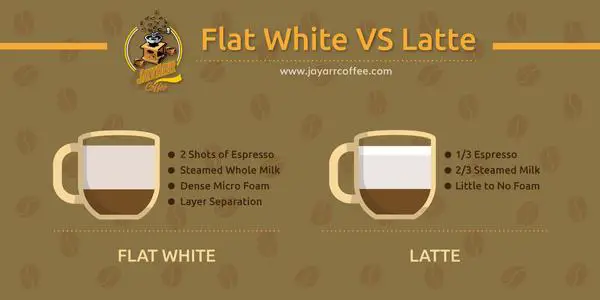
A few things separate a flat white from a latte. First, instead of the standard shots of espresso used in a latte, a flat white uses ristretto. Ristretto shots are espresso shots produced using the first pull/extraction out of the grounds by using a small water-to-grounds ratio and have a different flavor profile than a traditional espresso shot. Additionally, a flat white uses a relatively equal split of velvety foam and milk. In contrast, a latte is primarily milk and espresso with only a very light addition of foam. Lastly, the preparation and pouring of the milk in a flat white separates it from a traditional latte.
Flat White vs. Cappuccino
Flat whites are an espresso drink containing some foam and steamed milk, but what sets them apart from a cappuccino?
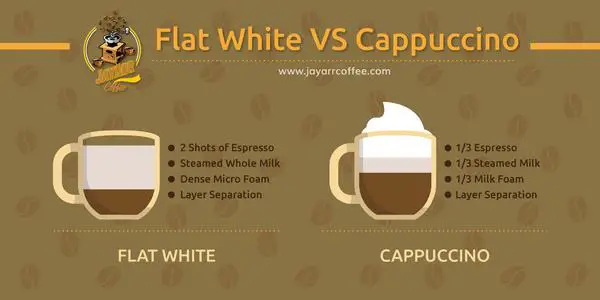
Cappuccinos are potent, smaller beverages created with espresso, steamed milk, and topped with a rich milk (usually dry) foam layer. Conventionally, a flat white is bigger, contains a more modest ratio of coffee to milk, and has a flatter, less dry, top foam layer.
Flat White Milk Prep and Pour: Defining a Flat White
Another distinction a flat white versus a latte is the manner in which milk is prepped and poured.
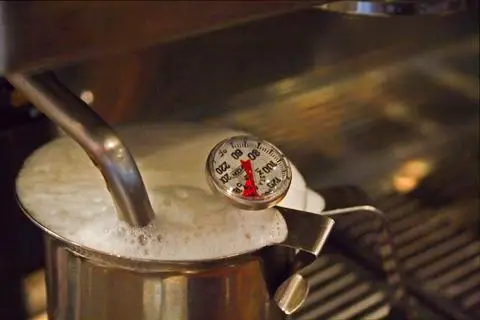
(By Original uploader was Tijuana Brass at en.wikipedia – Transfered from en.wikipedia Transfer was stated to be made by User:Tijuana Brass., CC BY-SA 3.0, https://commons.wikimedia.org/w/index.php?curid=3229067)
For a flat white, the milk should be prepped such that it:
- Has a firm froth (bigger bubbles)
- Produces velvety microfoam in the pitcher’s center (smaller bubbles)
- Has heated liquid milk at the pitcher’s bottom
Prepping milk for a flat white requires an essential milk “stretching” process via swirling, folding, and frothing it. The goal is to optimize the quantity of velvety microfoam by integrating the liquid milk and big bubbles. This microfoam is essential to producing the flat foam top that distinguishes a flat white.
When pouring, start a couple inches higher than the serving cup with the ristretto and aim for the exact center of the cup. As you approach the halfway point of the pour, slowly transition the pour closer to the cup.
Making a Flat White
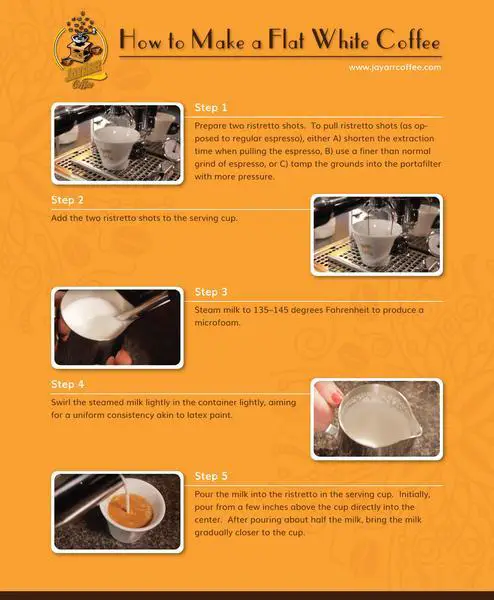
- Prepare two ristretto shots. To pull ristretto shots (as opposed to regular espresso), either A) shorten the extraction time when pulling the espresso, B) use a finer than normal grind of espresso, or C) tamp the grounds into the portafilter with more pressure.
- Add the two ristretto shots to the serving cup.
- Steam milk to 135–145 degrees Fahrenheit to produce a microfoam.
- Swirl the steamed milk lightly in the container lightly, aiming for a uniform consistency akin to latex paint.
- Pour the milk into the ristretto in the serving cup. Initially, pour from a few inches above the cup directly into the center. After pouring about half the milk, bring the milk gradually closer to the cup.
The Pouring of the Milk Distinguishes a Latte from a Flat White
The primary distinction between beverages (and baristas) is apparent when the steaming is complete and the drink is ready to be poured. A skilled barista will have the steamed milk swirled around so that the froth can be folded back into the liquid, producing a smooth velvet microfoam in the pitcher. The barista may bop the pitcher on a surface to pop any top bubbles (as an aspect of the milk folding step). However, this step can be bypassed if the milk is smoothly swirled.
Based on the speed of a pour, a skilled barista can pour directly from the pitcher on a slant to determine the amount of liquid milk, foam, or froth to add to any beverage. However, some common alternative methods to pour the three different drinks are:
| Flat White | Pour freely into the center to produce a velvety microfoam combination of liquid and froth (see more specific instructions above) |
| Cappuccino | Thick froth is added to a cup with a spoon before being topped up once poured from a pitcher. |
| Latte | Liquid milk is poured from the pitcher into the espresso, using a spoon to hold the froth back before topping it off with a dollop |
Making sure you’re drinking a flat white, and not a latte
An inexperienced barista may, unfortunately, make cappuccinos, lattes, and flat whites the same way, yielding nothing more than a latte each time. However, experienced specialty café baristas usually have a similar mindset – putting care into the individual steps of frothing, folding, and pouring the milk to produce the correct beverage.
Correct technique will give each beverage a distinct flavor. The tastes will differ due to the amount and type of the dilution of the coffee with milk. Each drink carries differences in taste, texture, and mouthfeel:
- A latte tastes milky with a rich mouthfeel and the small amount of foam on top of the coffee is relatively subtle
- A cappuccino has a more divided texture, an almost bubbly mouthfeel, and an in-your face, stiff foam at the top.
- A flat white tastes of a richer espresso, an integrated texture reflecting a balance of milk and espresso, and a mouthfeel of velvety foam and liquid milk.
To fully appreciate the distinction between all three drinks, visit several specialty cafés and taste each of them separately. The differences in texture should be pronounced.
Crema Integration: A Decent Flat White Test
Crema is the light orange/red caramelized layer on top of a shot of espresso produced when pulling the shot. Crema is made of coffee oils that accumulate as carbon dioxide escapes the grounds during brewing. Crema has a somewhat sweeter taste than the rest of the espresso and dissipates if dowsed in milk or if it sits long enough.
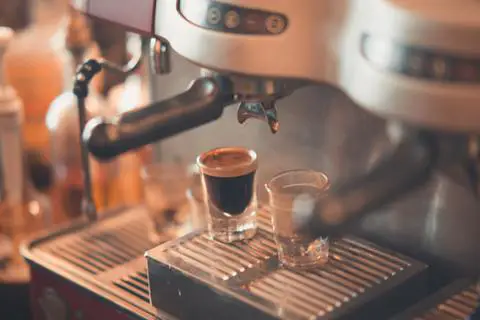
The crema of a cappuccino disappears into the drink under the beneath the stiff froth’s weight, while a latte typically dowses the crema with liquid milk. One way to tell if you’re drinking a quality flat white is by observing a smooth integration of the crema with the milk, leaving a balanced, cloudy orange swirl. This coloration can also serve as a nice jumping off point for latte designs!
Caffeine Content of a Flat White versus other Espresso drinks
The amount of caffeine in a flat white, or any other espresso drink, is directly related to the amount of caffeine in a shot of espresso and how much espresso used. However, as a proxy for total caffeine content, included below are the caffeine amounts Starbucks lists for a grande size of each of these drinks:
| Drink (Grande Size) | Caffeine Content |
| Flat White | 195 mg |
| Latte | 150 mg |
| Cappuccino | 150 mg |
| Espresso Macchiato (Doppio size) | 150 mg |
| Caramel Macchiato | 150 mg |
As you can see, a Starbucks flat white has more caffeine than other drinks of an equivalent size. However, this is because Starbucks uses 3 shots of ristretto for a flat white, while only using 2 shots of standard espresso for each of the other drinks.
Calories in a Flat White versus other Espresso drinks
The number of calories in a flat white, or in other espresso drinks, is dependent on customization of the beverage. However, as a proxy for total calories, included below are the total calories Starbucks lists for a grande size of each of these drinks with standard preparation:
| Drink (Grande Size) | Calories |
| Flat White | 220 |
| Latte | 190 |
| Cappuccino | 120 |
| Espresso Macchiato (Doppio size) | 15 |
| Caramel Macchiato | 250 |
What is an Iced Flat White?
Starbucks also sells an iced version of their flat white- the “iced flat white”. While many mock the iced flat white as a drink that seems to ignore a variety of the characteristics that define a flat white (proper flat white pouring technique, the smoothly integrated velvety foam top, etc.), an iced flat white is still different than an iced latte, as it utilizes ristretto shots instead of normal espresso as well as whole milk.
Lattes, Flat Whites, and Macchiatos: What Should I Order?
The right drink necessarily depends on what you taste you are looking for – an espresso forward or a milk forward drink:

For those who are partial to nuanced specialty coffee flavors but still want a milk-based espresso drink, consider choosing a flat white over a latte. Due to the reduced milk content, a flat white allows for more completely taking in the flavor profile of the espresso. A flat white integrates an espresso’s intensity and taste with the thick texture of a milk-based beverage.
We’d recommend trying one if you haven’t. It may replace the latte as your go-to morning beverage of choice.
